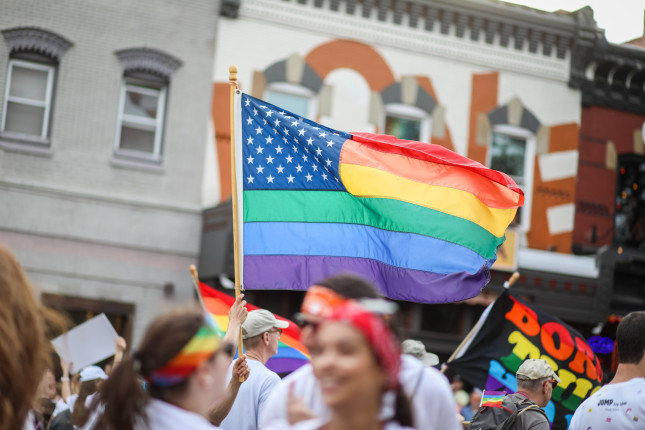-
Beyond Pride: Ensuring Affirming, Respectful Sexual and Reproductive Healthcare for LGBTQ+ Communities

In June 1969, the Stonewall Uprising in Manhattan served as a critical tipping point for the Gay Liberation Movement in the United States. Each June, communities around the world celebrate Pride Month to honor this struggle and continue fighting for a more equal future. More than 50 years after Stonewall, Lesbian, Gay, Bisexual, Transgender, and Queer or Questioning (LGBTQ+)* people in the United States struggle to access culturally competent and respectful sexual and reproductive health care.
Due to a history of discrimination and marginalization, LGBTQ+, or “queer,” individuals often live and work in socioeconomic conditions that can negatively impact their health. For example, they are disproportionately likely to live in poverty and be uninsured. For LGBTQ+ people of color, these inequities are compounded, as they also contend with racism in health care. These challenges are further exacerbated by barriers to accessing comprehensive sexuality education and the healthcare system more broadly.
Barriers in Sex Education
Many young LGBTQ+ people lack basic education that pertains to their sexuality. Sex education is often one of the only sources of comprehensive information on sex and sexuality for adolescents, and yet sex education, when it is taught, is often not medically accurate. It is also overwhelmingly heteronormative—the belief that heterosexuality is the default, preferred, or normal mode of sexual orientation—and excludes information about other identities and orientations.
While LGBTQ+ youth are in great need of comprehensive sex education, heteronormative sex education leaves them more vulnerable to preventable STIs and unintended pregnancies. Evidence shows that “queer” people who can get pregnant, excluding lesbians, are more likely than heterosexual people to have an unintended or teen pregnancy or have an abortion. This disparity can be attributed to both structural barriers to health care and poor sex education.
LGBTQ+ youth are also at greater risk of contracting STIs, but their sex education often does not teach them how to prevent these infections. Consequently, in the United States, gay and bisexual men ages 13-34 make up the majority of new HIV infections among all gay and bisexual men and boys, despite the fact that they do not engage in more frequent or more risky sexual behaviors than their heterosexual peers. Other research shows that lesbian and bisexual women are less likely than heterosexual women to perceive themselves of being at risk for STIs, which may lead to them engaging in less protected sex.
Only 7 percent of LGBTQ+ youth report having sex education that positively represented sexual orientation and gender identity topics. LGBTQ+ students are also 50 percent more likely than non-LGBTQ+ students to report that their sex education in school was not useful to them. Rather than funding comprehensive sexuality education, the federal government spends $110 million per year on abstinence-only sex education, which teaches young people to abstain from sex until they are in a heterosexual marriage. These programs not only fail to reduce rates of teen pregnancy and sexually transmitted infections (STIs), but promote shame and guilt around sex and create a culture of hostility for LGBTQ+ youth.
Barriers in the Healthcare System
Even if individuals have the requisite knowledge, barriers within the healthcare system can still prevent them from receiving sexual and reproductive health care. Providers are often unfamiliar with the kinds of care that LGBTQ+ patients need, which means many LGBTQ+ individuals do not receive comprehensive sexual health counseling and screening services even when seeking professional services.
There is long-standing, well-documented anti-LGBTQ+ bias in the medical system. This can be seen in examples such as the response to the HIV/AIDS epidemic in the 1980s and the treatment of homosexuality as a mental disorder by the American Psychiatric Association until 1987. To this day, a majority LGBTQ+ patients in the United States report experiencing discriminatory treatment from health care professionals.
These experiences can cause individuals to disengage from the healthcare system entirely. For example, almost 25 percent of transgender patients in the United States report delaying seeking health care due to concerns about mistreatment. Additionally, only 27 states have laws forbidding health insurance discrimination based on sexual orientation or gender identity, which places an additional financial burden on LGBTQ+ patients, particularly in the remaining 23 states.

The language used by medical providers can also create barriers for LBGTQI+ communities. Discussions about maternal and sexual and reproductive health often rely heavily on gendered terminology (e.g., “women’s” health services) and care is often provided in highly gendered environments. However, cisgender individuals—individuals whose gender identity matches the sex they were assigned at birth—are not the only ones who need these vital health services. For example, trans men need Pap smears and other gynecological exams. They also can and do become pregnant. Exclusively referring to individuals who need these services as “women” and “mothers” erases this reality.
The consequences of this erasure are two-fold. First, it further reduces the visibility of LGBTQ+ populations in sexual and reproductive healthcare spaces, making it even less likely that providers will be knowledgeable about their needs and able to render appropriate care. Second, it can be an indication to LGBTQ+ individuals that a particular provider may not be accepting and discourage them from seeking care. To combat this, advocates and practitioners are increasingly shifting to more inclusive, gender neutral phrases such as “pregnant people,” “parents,” and “sexual and reproductive” (as opposed to “women’s”) health services.
Heteronormative assumptions in the healthcare system’s data infrastructure can also create issues for LGBTQ+ patients. Electronic medical records may prevent physicians from recording diagnostic codes that are inconsistent with a patient’s sex or gender as registered in the system. For similar reasons, an insurance company may automatically deny a claim to cover a transgender man’s pregnancy care or a transgender woman’s prostate exam. Failure to collect data on sexual orientation and gender identity can also render LGBTQ+ communities invisible in public health research and surveillance.
Implications for Policy and Practice
“While I am proud of the progress my Administration has made in advancing protections for the LGBTQ+ community, I will not rest until full equality for LGBTQ+ Americans is finally achieved and codified into law,” wrote President Biden.
In May 2021, the Biden Administration declared that the federal government will protect LGBTQ+ people against sex discrimination in healthcare, reversing a Trump Administration policy that narrowed protections by defining sex as gender assigned at birth. LGBTQ+ rights advocates say this reversal aligns health policy with a 2020 Supreme Court decision that protects LGBTQ+ people from workplace discrimination. President Biden remains committed to advancing LGBTQ+ protections in health policy and all facets of life. He continues to urge Congress to pass the Equality Act and, on June 1, 2021, issued a federal proclamation in recognition of LGBTQ+ Pride Month.
Nevertheless, much remains to be done. “While I am proud of the progress my Administration has made in advancing protections for the LGBTQ+ community, I will not rest until full equality for LGBTQ+ Americans is finally achieved and codified into law,” wrote President Biden in his Pride Month proclamation. Ensuring true equality in access and outcomes will require that policymakers and practitioners intentionally and explicitly include LGBTQ+ populations in all aspects of healthcare—including sexual and reproductive health education and services.
*In this piece, we use the term LGBTQ+ because it is the most common acronym used in the United States and the acronym currently being used by the Biden Administration. Other variations include other letters, such as “I” for Intersex, “A” for asexual, and “2S” for two-spirit (a term used by Indigenous communities in North America). In this piece, the “+” is meant to add inclusivity and signify all other gender identities and sexual orientations that are not covered by the five initials in the acronym.
Sources: American Psychological Association; AP News; BBC News; Behavioral Sciences; Centers for Disease Control; Congress.gov; Guttmacher Institute, History Channel; Lambda Legal; Library of Congress; MedicalNewsToday; Movement Advancement Project; National Center for Transgender Equality; New York Times; NPR; Obstetrics & Gynecology; PBS; Reproductive Health Journal; Sexuality Information and Education Council of the United States; The National Academies of Sciences, Engineering, and Medicine; UCSF Transgender Care; White House; Williams Institute.
Photo Credit: The Capital Pride Parade takes place every year on a Saturday in June between Dupont Circle and Logan Circle, cover photo, in text photo, Nicole Glass Photography/Shutterstock.com, All Rights Reserved.
 A Publication of the Stimson Center.
A Publication of the Stimson Center.




